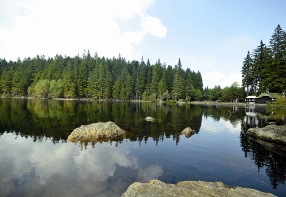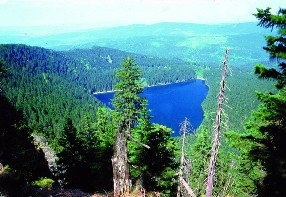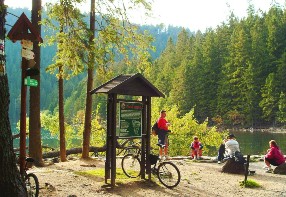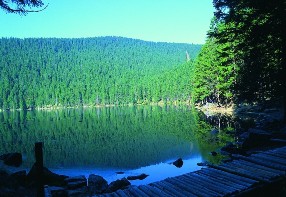BLACK AND DEVIL'S LAKES NATIONAL NATURE RESERVE
Being the only glacier lakes in the Czech Republic, they represent the greatest natural treasure not only in the region of Železná Ruda but also in the Šumava and the Bavarian Forest. Local atmosphere changes with different times of the day and of the year. They represent beautiful places for relaxation and contemplation. The visitors of the Železná Ruda region should not omit a visit to this unique scenery.
What is the origin of the Šumava lakes? By the end of the Tertiary climate cooling gave birth to the snow glacier avalanches on the slopes. The glaciers later gradually melted and slid down while pushing huge amounts of stones and gravel ahead. These formed massive dams underneath the slopes - so-called moraine dams - that were holding water.Though situated close to each other, the lakes are split by the main Europen watershed divide passing the saddle of Rozvodí (the site of medieval mines of iron ore), the peak of Špičák mountain, Špičák saddle and partially along the ridge and slope of Pancíř mountain. The Devil's Lake falls into the drainage area of the Black Sea, while the Black Lake into the drainage area of the North Sea.
The Black and Devil's Lakes National Nature Reserve covers an area of 152 hectares and was declared by the Prince of Hohenzollern in 1911 upon the impulse of the founder of modern nature protection (especially of lakes and glacier cirques with rare fauna and flora species) - Hugo Connwentz.
Black Lake (Čertovo jezero)
With its surface of 18,43 hectares, it is the largest and deepest (maximum depth of 40 m) lake in the Šumava and the Bavarian Forest. Its altitude is on the other hand the lowest amongst the other Šumva lakes (1008 m). The name comes from the apparently black colour of its waters, which is due to reflection of the surrounding dense forests. A tourist cottage used to stay by the lake, later a restaurant and - until recently - the seat of the border patrol. Today, there is only a small house providing regulation of water outflow into the power station.
Amongst the rare flora and fauna species we should name the covers of lake quillwort and Europena bur-reed. On the wall facing north, there are arctic-alpine flora species. Rare species of invertebrates also live in the lake. A 300 m high wall of Jezerní mountain is rising above the surface. With the altitude of 1343 m above see level, it is the highest peak of the region of Železná Ruda.
The Black Lake also has a technical monument - the pumped-storage power plant with the output of 1,5 MW. As the first power station of this type built by Škodovy závody Plzeň and put into operation in 1930, it has been listed amongst historical technical monuments. The equalization basin is placed deep in the Úhlava valley and is connected with the Black Lake by a 2 km long conduit with super-elevation of 280 m.
The atmosphere of the Black Lake inspired many significant writers, poets and composers - Antonín Dvořák, Jan Neruda, Alois Vojtěch Šmilovksý, Jaroslav Vrchlický, Adolf Heyduk, etc.
Devil's Lake
With its area of 10,33 hectares, the Devil's Lake is the second largest in the Šumava. It lies in the altitude of 1030 m and its maximum depth is 37 m. The lake is fed by groundwater as well as affluent streams on the ground. The lake wall is not as impressive as the one of the Black Lake. In the past, there was an observational footpath in the lake wall built in 1880-1882 from the order of the Prince of Hohenzollern at a price of 3 500 guldens. The construction was initiated and managed by the head forester Julius Komárek - a patriot promoting extensive access to local forests. Komárek was a father of the Professor Julius Miloš Komárek born in 1892 in Železná Ruda - a significant scientist in the fields of zoology, entomology, forest protection and game management, who founded and managed the Forestry and Game Management Research Institute and was a Dean of the Faculty of Science of Charles University. He was one of the initiators of establishment of national parks in the Tatras and the Šumava.
The location has been protected since 1933 already (by the decree of the Ministry of Education and Public Education No. 143547/33). The principles of conservation were nevertheless originally not contradictory to the "soft" tourism and hiking. The footbridges on the paths, formerly also used by the border patrols, were absurdly removed by conservationists in 1990.
All today's attempts for recovery of the footpath by the municipality of Železná Ruda meet with opposition and encounter negative expert opinions in respect with the alleged negative environmental impact (habitat of Cantabrian Capercaillie).
On their journey from Železná Ruda to the Devil's Lake, the tourist pass a memorial of Adolf Kašpar, paying tribute to this famous painter, besides else also the first illustrator of Babička (The Grandmother) by Božena Němcová.




